Modeling of Metal Powder Densification under Hot Isostatic Pressing
Abstract
:1. Introduction
2. Materials and Methods
3. Simulation Model
- (1)
- The geometry of the powder and container was defined.
- (2)
- The thermal property parameters and rheological curves calculated by JMatPro V10.0 software were used to define the material model.
- (3)
- A finite element mesh was generated in the powder and in the container.
- (1)
- The thermal and pressure boundary conditions on the outside surface of the container were specified. The temperatures were 1050 °C, 1150 °C, and 1250 °C, respectively. The pressure was 130 MPa and was loaded from outside to inside.
- (2)
- The heat transfer and friction conditions between the powder and the container were specified. The thermal conductivity was assigned to be 11 W/(m·K), and the friction coefficient was 0.3.
- (3)
- The simulation was started, to last for 4 h.
- (4)
- When the shape change caused a degeneration of the finite element mesh, automatic re-meshing was performed to keep the mesh suitable for accurate calculations.
- (5)
- The simulation was stopped at the end of 4 h (HIP time).
- (6)
- The results were post-processed.
4. Results and Discussion
5. Conclusions
- (1)
- The densification distribution of the HIPed billet was radial, and the densification rate of the central part was slower than that of the corner.
- (2)
- The 316 L stainless steel powder could be densified with a relative density over 99% processed at 1050 °C/130 MPa/4 h, 1150 °C/130 MPa/4 h, and 1250 °C/130 MPa/4 h, respectively. The size difference between the simulation and experimental results of relative density of specimens for any position was less than 2%.
- (3)
- Increasing the temperature could lead to faster densification.
- (4)
- Experimental validations demonstrated that the model could accurately predict the changes in container size and relative density during HIP process.
Author Contributions
Funding
Informed Consent Statement
Data Availability Statement
Conflicts of Interest
References
- Yan, S.; Wang, Q.; Chen, X.; Zhang, C.; Cui, G. Fabrication of highly compact Inconel 718 alloy by spark plasma sintering and solution treatment followed by aging. Vacuum 2019, 163, 194–203. [Google Scholar] [CrossRef]
- Dabala, M.; Polyakova, M. Characterization of a 17-4 PH stainless steel obtained through metal powder Hot Isostatic Pressing process for automotive application. IOP Conf. Ser. Mater. Sci. Eng. 2020, 986, 012030. [Google Scholar] [CrossRef]
- Liu, H.; Wang, L.; Jiang, Y.; Li, S.; Liu, D.; Ji, Y.; Zhang, F.; Chen, D. Study on SiO2 thin film modified by post hot isostatic pressing. Vacuum 2018, 148, 258–264. [Google Scholar] [CrossRef]
- Kamada, S.; Xiao, T.; Wang, R. Fabrication of CrMnFeCoNi high-entropy alloy by sparkplasma sintering and evaluation of mechanical properties. Proc. Conf. Chugoku-Shikoku Branch 2021, 59, 03a1. [Google Scholar] [CrossRef]
- ElRakayby, H.; Kim, K. Effect of glass container encapsulation on deformation and densification behavior of metal powders during hot isostatic pressing. Int. J. Mater. Form. 2017, 11, 517–525. [Google Scholar] [CrossRef]
- Penther, D.; Ghasemi, A.; Riedel, R.; Fleck, C.; Kamrani, S. Effect of SiC nanoparticles on manufacturing process, microstructure and hardness of Mg-SiC nanocomposites produced by mechanical milling and hot extrusion. Mater. Sci. Eng. A 2018, 738, 264–272. [Google Scholar] [CrossRef]
- Liu, H.-S.; Zhang, L.; He, X.-B.; Qu, X.-H.; Li, Z.; Zhang, G.-Q. Precipitation behavior of γ′ phase in superalloy FGH96 under interrupted cooling test. Rare Met. 2013, 32, 560–563. [Google Scholar] [CrossRef]
- Guo, R.P.; Xu, L.; Wu, J.; Lu, Z.G.; Yang, R. Simulation of Container Design for Powder Metallurgy Titanium Components through Hot-Isostatic-Pressing. Mater. Sci. Forum 2015, 817, 610–614. [Google Scholar] [CrossRef]
- Sobhani, S.; Gandy, D.; Albert, M.; Tabei, A. Computational investigation of particle segregation in capsule filling for hot isostatic pressing. Simul. Model. Pr. Theory 2023, 126, 102751. [Google Scholar] [CrossRef]
- Swinkels, F.B.; Wilkinson, D.S.; Arzt, E.; Ashby, M.F. Mechanisms of Hot isostatic Pressing. Acta Met. 1983, 31, 1829–1840. [Google Scholar] [CrossRef]
- Sreenu, B.; Sarkar, R.; Kumar, S.S.; Chatterjee, S.; Rao, G.A. Microstructure and mechanical behaviour of an advanced powder metallurgy nickel base superalloy processed through hot isostatic pressing route for aerospace applications. Mater. Sci. Eng. A 2020, 797, 140254. [Google Scholar] [CrossRef]
- Cooper, R.D.; Fathauer, P.; Mroczek-Petroski, A.; Perry, D.; Petroski, J.J. Polishing Pad for Use in Chemical—Mechanical Palanarization of Semiconductor Wafers and Method of Making Same. US20050085169A1, 22 April 2024. [Google Scholar]
- Lee, Y.; Nandwana, P.; Simunovic, S. Powder spreading, densification, and part deformation in binder jetting additive manufacturing. Prog. Addit. Manuf. 2021, 7, 111–125. [Google Scholar] [CrossRef]
- Manière, C.; Durand, L.; Estournès, C. Powder/die friction in the spark plasma sintering process: Modelling and experimental identification. Scr. Mater. 2016, 116, 139–142. [Google Scholar] [CrossRef]
- Jinka, A.K.; Lewis, R.W. Finite element simulation of hot isostatic pressing of metal powders. Comput. Methods Appl. Mech. Eng. 1994, 114, 249–272. [Google Scholar] [CrossRef]
- Du, Y.-Y.; Shi, Y.-S.; Wei, Q.-S.; Liu, J.H. Simulation and Experiment of Cold Isostatic Pressing of Stainless Steel Powder. J. Mater. Eng. 2010, 30, 89–92. [Google Scholar] [CrossRef]
- Zahrah, T.F.; Kecskes, L.; Rowland, R. High-Density Metallic-Glass-Alloys, Their Composite Derivatives and Methods for Making the Same. U.S. Patent 2006062684A1, 26 February 2024. [Google Scholar]
- ElRakayby, H.; Kim, K. Deformation and densification behaviours of nickel-based superalloy during hot isostatic pressing. Powder Metall. 2017, 60, 293–300. [Google Scholar] [CrossRef]
- Uematsu, K.; Itakura, K.; Sekiguchi, M.; Uchida, N.; Saito, K.; Miyamoto, A. Grain Growth During Hot Isostatic Pressing of Presintered Alumina. J. Am. Ceram. Soc. 1989, 72, 1239–1240. [Google Scholar] [CrossRef]
- Rios, A.C.; Olevsky, E.; Hryha, E.; Persson, M.; Bordia, R.K. Analytical models for initial and intermediate stages of sintering of additively manufactured stainless steel. Acta Mater. 2023, 249, 118822. [Google Scholar] [CrossRef]
- Van der Laan, A.; Epherre, R.; Estournes, C. Numerical approach for the determination of multi-mechanisms of the densifcation of TiAl by spark plasma sintering. Intermetallics 2022, 141, 107435. [Google Scholar] [CrossRef]
- Rajaei, A.; Deng, Y.; Schenk, O.; Rooein, S.; Bezold, A.; Broeckmann, C. Numerical Modelling of the Powder Metallurgical Manufacturing Chain of High Strength Sintered Gears. Chin. J. Mech. Eng. 2021, 34, 143. [Google Scholar] [CrossRef]
- Elguezabal, B.; Alkorta, J.; Martínez-Esnaola, J.M. Study of Astroloy powder compaction at high temperature under hydrostatic load using finite elements—ScienceDirect. Powder Technol. 2020, 381, 92–100. [Google Scholar] [CrossRef]
- Brodziak-Hyska, A.; Stradomski, Z.; Kolan, C. Kinetics of the σ Phase Precipitation in Respect of Erosion-corrosion Wear of Duplex Cast Steel. Arch. Foundry Eng. 2014, 14, 17–20. [Google Scholar] [CrossRef]
- Elguezabal, B.; Alkorta, J.; Martínez-Esnaola, J.M.; Soler, R.; Paños, E. Study of powder densification under hydrostatic loads at high temperatures using finite element method. Procedia Manuf. 2020, 50, 401–406. [Google Scholar] [CrossRef]
- Guo, R.P.; Xu, L.; Bai, C.G.; Wu, J.; Wang, Q.J.; Yang, R. Effects of can design on tensile properties of typical powder metallurgy titanium alloys. Chin. J. Nonferrous Met. 2014, 24, 2050–2056. [Google Scholar]
- Escriba, D.M.; Materna-Morris, E.; Plaut, R.; Padilha, A.F. Intermetallic Phase Precipitation in Duplex Stainless Steels during High Temperature Exposition. Mater. Sci. Forum 2010, 636–637, 478–484. [Google Scholar] [CrossRef]
- Svoboda, A.; Haeggblad, H.A.; Naesstroem, M. Simulation of hot isostatic pressing of metal powder components to near net shape. Eng. Comput. 1996, 13, 13–37. [Google Scholar] [CrossRef]
- Vadolia, G.R.; Singh, K.P.; Gupta, M.K.; Doshi, B.; Rathore, V. Introduction to Isostatic Pressing and Its Optimization. Modeling and Optimization in Manufacturing: Toward Greener Production by Integrating Computer Simulation; Wiley: New York, NY, USA, 2021; pp. 157–192. [Google Scholar] [CrossRef]
- Zou, Y.; An, X.; Zou, R. Investigation of densification behavior of tungsten powders during hot isostatic pressing with a 3D multi-particle FEM approach. Powder Technol. 2020, 361, 297–305. [Google Scholar] [CrossRef]
- Lang, L.H.; Bu, G.L.; Xue, Y.; Zhang, D.X. Determine key parameters of simulation constitutive and process optimization for titanium alloy(Ti-6Al-4V) hot isostatic pressing. Suxing Gongcheng Xuebao/J. Plast. Eng. 2011, 18, 34–38. [Google Scholar] [CrossRef]
- Ren, X.; Wang, E.; Huo, W. The Yield Criterion of Powder Compact. Powder Metall. Technol. 1992, 10, 8–12. [Google Scholar]
- DeLo, D.; Piehler, H. Early stage consolidation mechanisms during hot isostatic pressing of Ti–6Al–4V powder compacts. Acta Mater. 1999, 47, 2841–2852. [Google Scholar] [CrossRef]
- Li, W.B.; Easterling, K.E. Cause and effect of non-uniform densification during hot isostatic pressing. Powder Metall. 1992, 35, 47–52. [Google Scholar] [CrossRef]
- Abouaf, M.; Chenot, J.L.; Raisson, G.; Bauduin, P. Finite element simulation of hot isostatic pressing of metal powders. Int. J. Numer. Methods Eng. 1988, 25, 191–212. [Google Scholar] [CrossRef]
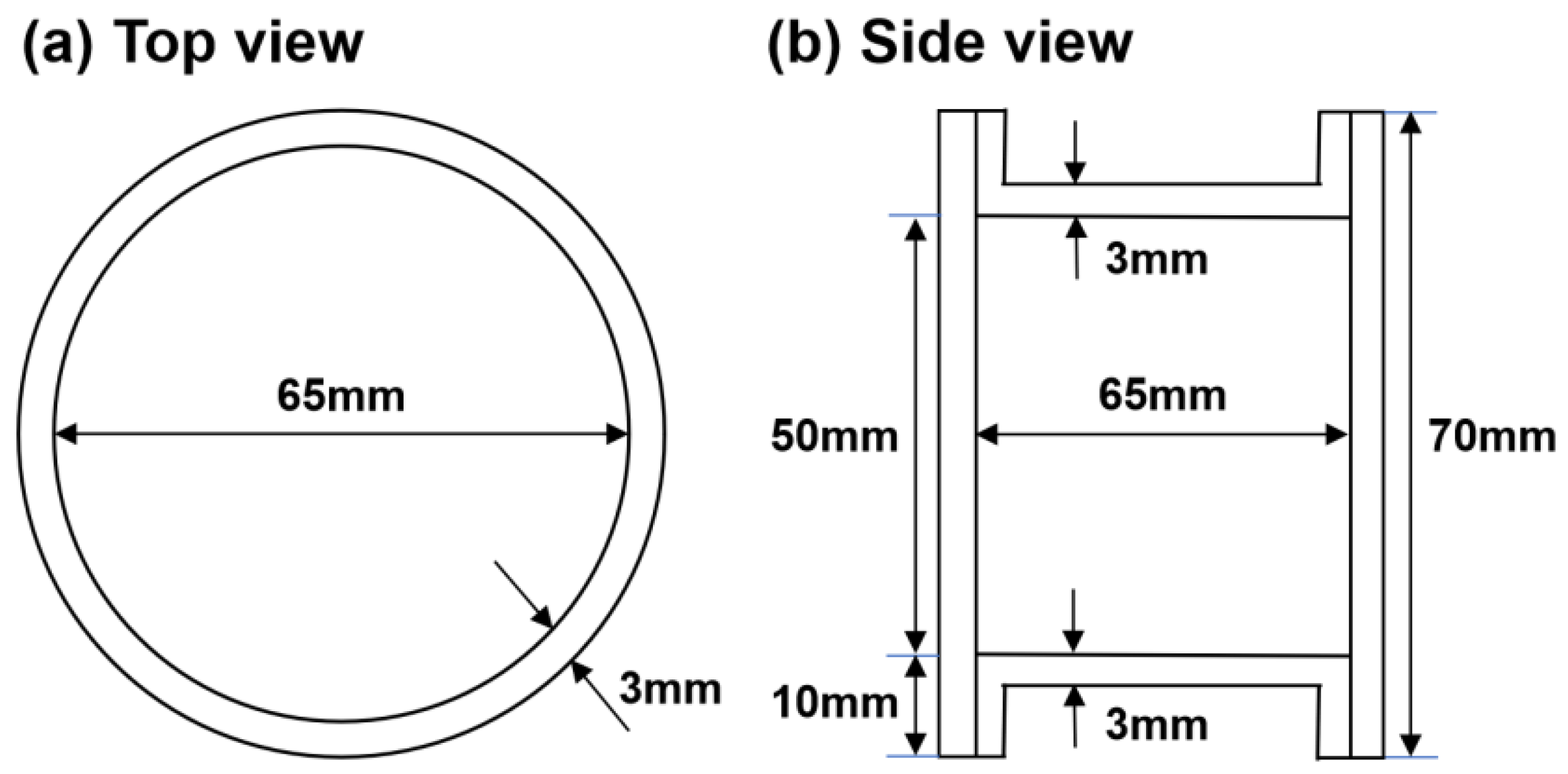
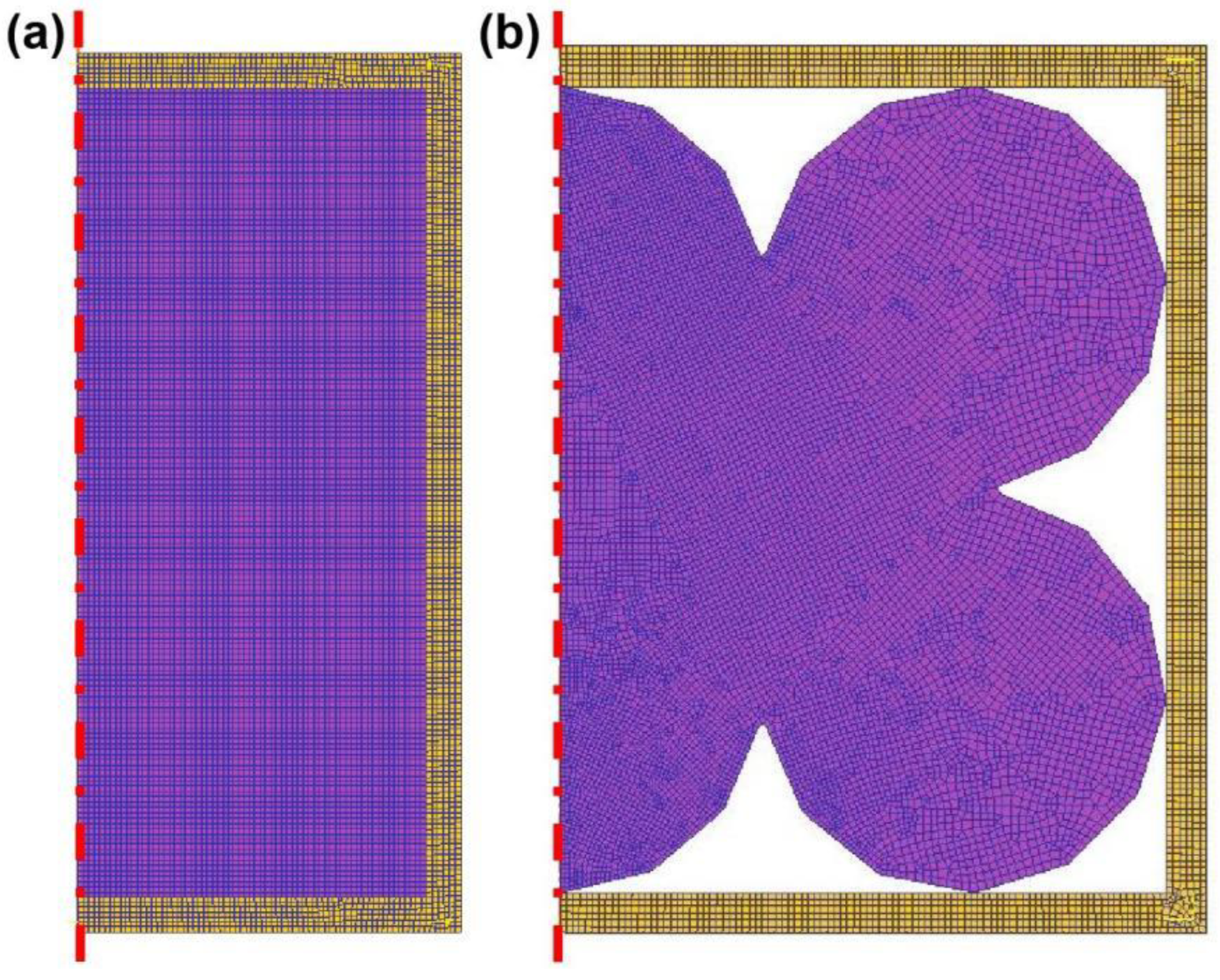


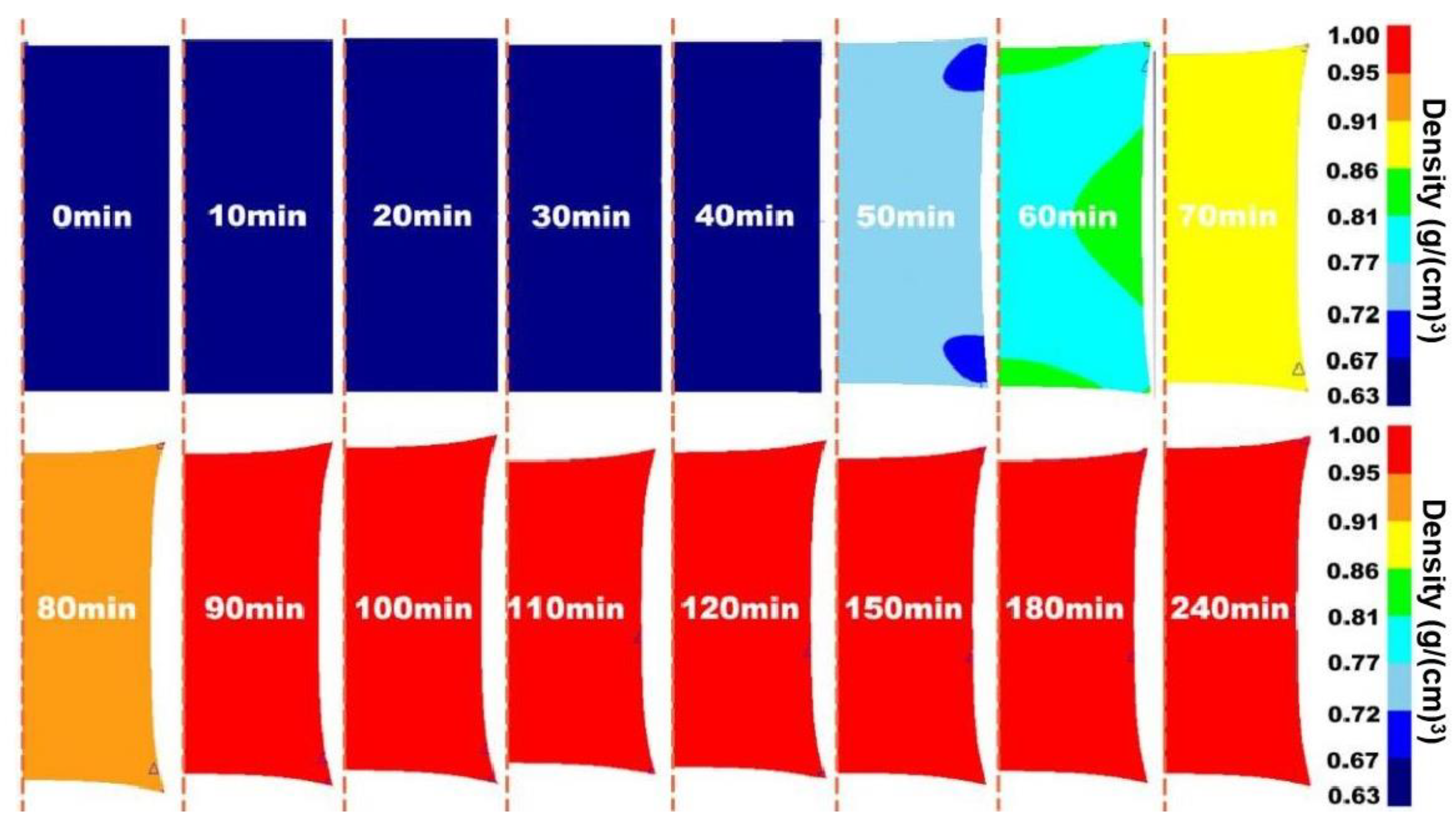




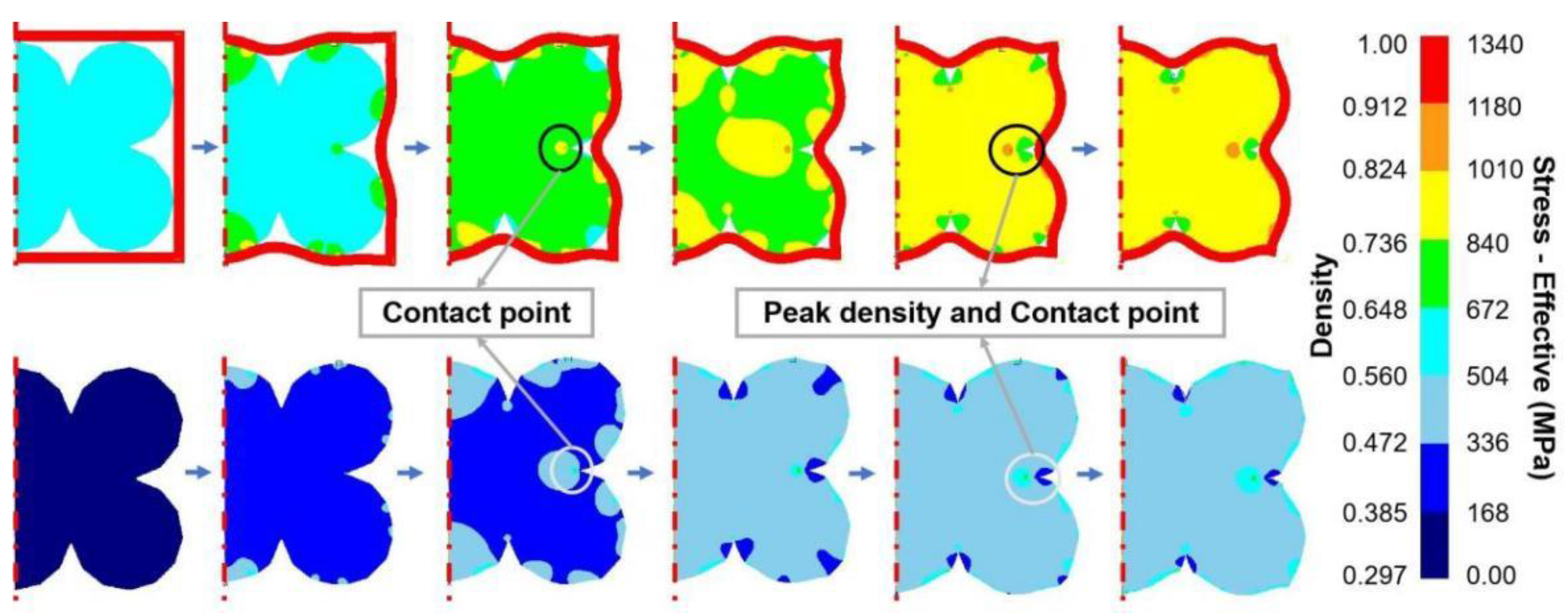
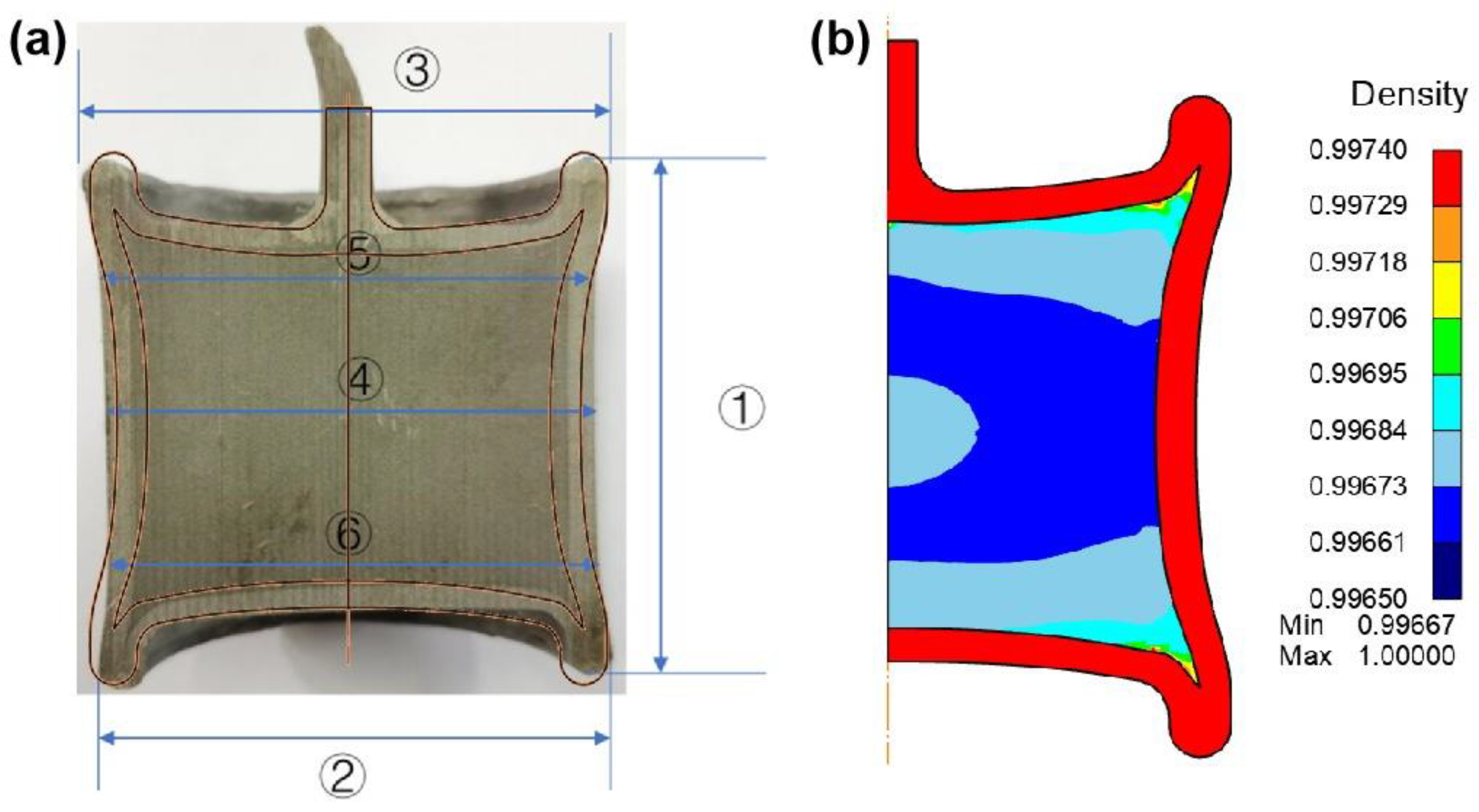
| Element | C | Si | Mn | Mo | Ni | Cr | Fe |
|---|---|---|---|---|---|---|---|
| Wt.% | 0.023 | 0.73 | 1.74 | 2.66 | 13.1 | 17.3 | Bal. |
| Element | C | Mn | P | S | Si | Cr | Ni | Cu | Fe |
|---|---|---|---|---|---|---|---|---|---|
| Wt.% | 0.18 | 0.39 | 0.014 | 0.005 | 0.18 | 0.01 | 0.01 | 0.01 | Bal. |
| Position | Experimental size (mm) | FEM dimension (mm) | Error (%) | ||
|---|---|---|---|---|---|
| Before HIP | After HIP | Before HIP | After HIP | ||
| ① | 73.4 | 68.66 | 73.4 | 67.53 | −1.65 |
| ② | 71.1 | 68.66 | 71.1 | 68.68 | 0.03 |
| ③ | 71.1 | 68.66 | 71.1 | 68.68 | 0.03 |
| ④ | 71.1 | 64.04 | 71.1 | 61.43 | −4.08 |
| ⑤ | 71.1 | 64.20 | 71.1 | 65.24 | 1.62 |
| ⑥ | 71.1 | 64.20 | 71.1 | 65.24 | 1.62 |
Disclaimer/Publisher’s Note: The statements, opinions and data contained in all publications are solely those of the individual author(s) and contributor(s) and not of MDPI and/or the editor(s). MDPI and/or the editor(s) disclaim responsibility for any injury to people or property resulting from any ideas, methods, instructions or products referred to in the content. |
© 2024 by the authors. Licensee MDPI, Basel, Switzerland. This article is an open access article distributed under the terms and conditions of the Creative Commons Attribution (CC BY) license (https://creativecommons.org/licenses/by/4.0/).
Share and Cite
Wang, J.; Srivatsa, S.; Wu, Z.; Huang, Z. Modeling of Metal Powder Densification under Hot Isostatic Pressing. Materials 2024, 17, 1933. https://doi.org/10.3390/ma17081933
Wang J, Srivatsa S, Wu Z, Huang Z. Modeling of Metal Powder Densification under Hot Isostatic Pressing. Materials. 2024; 17(8):1933. https://doi.org/10.3390/ma17081933
Chicago/Turabian StyleWang, Jingzhe, Shesh Srivatsa, Zhanfang Wu, and Zaiwang Huang. 2024. "Modeling of Metal Powder Densification under Hot Isostatic Pressing" Materials 17, no. 8: 1933. https://doi.org/10.3390/ma17081933





